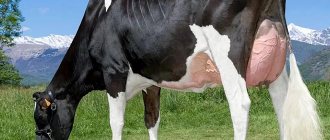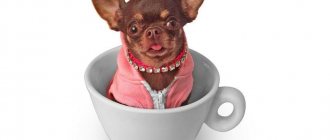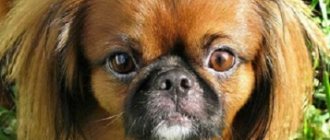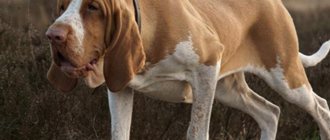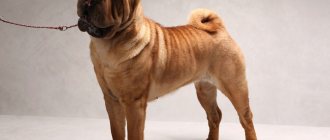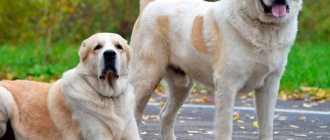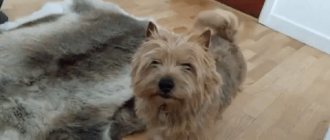Kholmogory geese are one of the best meat birds. Individuals are hardy and viable birds with a strong build and non-aggressive character. Individuals take root in any region, but show better productivity in warm climates.
White goose of the Kholmogory breed
Kholmogory goose gray-white
Gray goose Kholmogor
What does the breed look like?
Geese of the Kholmogory breed have a horizontally placed round body and large breasts. The weight of an adult goose is 8 kg, a gander is 12 kg. The plumage is white, gray and intermediate piebald. External differences between the Kholmogors and other breeds are a bump at the base of the beak and a pronounced fold under it; a fold, clearly visible, is also present on the belly. The legs are orange, the beak of white geese is the same color, and that of dark geese is black.
During the war, the breed was almost lost, but thanks to the efforts of breeders, in 2022 Kholmogory geese look exactly the same as when they were bred.
History of creation
“Kholmogory” were bred in the 19th century in the Arkhangelsk region by crossing Chinese and Arzamas geese. Next, selective work was carried out to select the largest, fastest-growing individuals that had good health and were able to gain weight well on pasture.
The breed's popularity was at its peak until World War II. When the fighting ended, farmers had no time for purebred breeding. The main goal at that time was to feed the population. Therefore, many owners infused various blood in order to improve egg production, early maturity and other qualities necessary at that time, and therefore the breeding material was practically lost.
Important: Kholmogory geese are often crossed with other breeds (for example, Lindovskaya) to increase the body weight of the young.
Modern “Kholmogory” people are very different from the original ones, which existed until the 40s of the last century
Conditions and care
Geese of the Kholmogory breed were bred to adapt to the cold; they can be kept in any region of Russia. Any suitable utility room can be adapted for a goose barn or built specially. The poultry house should be dry, clean and light. Before birds move into it, you need to check the walls and ceiling and repair them so that there are no drafts, which geese do not like. For summer maintenance, you can organize a poultry house from a wooden frame, mesh covered with film or roofing felt.
See also
Symptoms of worms in geese and treatment with drugs and folk remediesRead
The area of the poultry house is calculated based on the number of livestock; each bird should have 1 square meter. m. of space. The walking area is 2-3 times larger. Conditions of keeping: clean bedding and equipment. Sand, peat, straw or hay chaff are used for bedding. As soon as the litter becomes dirty and damp from droppings, it is replaced. The room is ventilated every day.
Goose house equipment - cleaning equipment, feeders and drinking bowls - must also be clean and disinfected. Feeders are made of metal for wet mixtures and wood for dry mixtures. The size of the feeders should be such that all the livestock can approach the food at the same time.
You should not allow many birds to live in the house at the same time. Crowding is always bad for pets. The proximity of individuals to each other, pollution of litter and air leads to mass diseases. To somehow solve this problem, Kholmogory geese can be kept in a walking yard all the time in the summer, if it is protected from precipitation and predators.
Basic rules for choosing good individuals
In order not to have the hassle of raising Kholmogory chicks on your own, you can immediately buy the required number of young individuals. The survival rate of goslings with good maintenance is very high. Here are a few rules for choosing good representatives of this breed:
- Pay attention to bird activity. Young individuals of Kholmogory are always on the move.
- Chicks should have a good appetite. If you give them food, then healthy goslings will immediately run up to eat it, but the weak ones will remain on the sidelines and will not show interest in food.
- Juveniles begin to fuss when there are loud sounds or noise nearby.
- The down of healthy individuals is shiny and evenly covers the body of the goslings. There should be no bare areas of skin.
- The belly of goslings should be smooth and round.
Features of feeding
The diet of Kholmogory geese does not differ from that of geese of other breeds. Kholmogory eat everything that is offered to them and do not go overboard with food. Their main food is fresh grass and wet mash. Mash is prepared from grain chaff, cake, bran, vegetables and root vegetables, and sprouted grains. If there is a pasture with grass nearby, the geese can be grazed there and only fed with grain in the evening.
If there is no opportunity to graze the bird, you need to feed it 2 or 3 times a day. Give grass clippings first, then grain mash. The amount of food should be such that the geese have time to eat it in half an hour. Water must be present in the house at all times; it must be changed every day. Geese fatten well on complete feed. Apart from mixtures and water, they don’t need anything else.
With proper feeding, Kholmogory geese begin to lay eggs in early spring. At this time, 1 hen needs about 150 g of grain, 100-150 g of grass or grass meal, 300-500 g of root vegetables. Premixes, chalk and salt are added to the mash to improve the quality of egg products and the strength of the shell. Fine gravel or sand is poured into a separate bowl. Birds need pebbles for normal digestion.
Goslings are kept for fattening for up to 5-6 months. Until this age, they grow rapidly and show the largest gains. Then the growth rate decreases, feed costs increase, and accordingly, the cost of production increases.
See also
Description of the Tula fighting breed geese, their characteristics and breedingRead
Hatching egg
A little about the incubation process.
The shape of the eggs should be smooth, without cracks or protrusions; their shells cannot be washed, so keep the nests clean.
Since goose eggs are quite large, you need to turn them regularly for the first 2 weeks. Otherwise, the egg does not have time to cool well, and gas exchange inside is disrupted. The hatched goslings must be placed in a box with sides no lower than 25 cm, and heated with a lamp or heating pad.
In the first days of life, the temperature of the heating pad is 24-28 degrees, by the age of three weeks it drops to 18.
Breeding nurseries and prices
Thanks to rapid acclimatization and unpretentiousness, Kholmogory are distributed almost throughout Russia. They are bred in Udmurtia, in the Oryol, Voronezh, Bryansk, and Kursk regions.
If you decide to buy Kholmogory goose, it is important to choose a trusted supplier with good reviews from farmers. Here are several farms that offer goslings and adults of the Kholmogory breed: Here are several farms that offer goslings and adults of the Kholmogory breed:
Here are several farms that offer goslings and adults of the Kholmogory breed:
Average prices on farms are:
- Eggs for incubator – from 180 rub.
- Daily allowance for babies - from 200 rub.
- 4-month-old goslings – from 2000 rub.
- Adults – from 3500 rub.
Subtleties of breeding
Until 5-6 months, it is difficult to distinguish Kholmogory geese by gender. Birds older than this age develop bumps on their beaks, which can be used to determine where the males are and where the females are.
A goose family for obtaining eggs is formed from 1 gander and 4 geese. In order for females to lay eggs, a nest must be placed in the poultry house for each family. You need to select the demolished fish every day if you plan to hatch young animals in an incubator. But you can leave the eggs to the females so that one of them decides to incubate. Kholmogory geese are responsible hens and caring mothers. The young under the goose are well preserved, do not get sick or die.
The temperature and humidity conditions for incubating eggs of Kholmogory geese are exactly the same as for other breeds of the species. Young animals can be hatched in a regular small incubator for home use.
After hatching, the goslings are raised in a brooder until they reach one month of age. In the first days, the brood is fed frequently - 6-7 times a day; by the age of one month, the frequency is increased to 3 times. The goslings' first food is a mixture of boiled eggs, cottage cheese, and herbs. From 3-4 days you can start giving cut grain. Take them out for walks a week after hatching, first for half an hour. 2-month-old goslings can be left outside all day.
Productivity characteristics
Kholmogory geese are considered long-lived, they can live up to 15-17 years, and from the age of 3 they are considered adults. At this age, the greatest ability for fertilization is noted. One female of this breed can lay up to 30-40 eggs per year. They can be considered large, because their mass is in the range of 180-200 g.
Goslings grow quickly and by 60 days of life they weigh as much as 4-4.5 kg. At this time they can already be slaughtered. The maximum weight that purebred geese can gain is much greater and is 8-12 kg for a goose and 7-9 kg for a goose.
We recommend reading
When do geese start laying eggs at home?
What can you feed goslings from the first days of life?
Common diseases
Geese of the Kholmogory breed can suffer from infectious diseases. They are especially dangerous for young animals. If an infection occurs in a poultry house, the death of most of the flock can be expected. You should not wait until diseases appear; it is necessary to regularly carry out preventive treatments of poultry with antibacterial and antiviral drugs. When the first signs of illness appear, contact your veterinarian immediately.
Feeding disorders and poisonings are also common among turkeys. Their cause is improper feeding, improper selection of feed, and overfeeding. Control measures: review the composition of the diet, remove foods that can cause illness, keep turkeys without food for 24 hours.
Description
Representatives of purebred geese have a strong, well-built massive and long body, a wide chest, and an elongated straight back. The beak of these birds is slightly curved. On the forehead of white birds there is an orange bump, while in birds with gray plumage this area is dark. In addition, Kholmogors have several folds under the beak, which are called a purse. Two more folds are present on the abdomen. The metatarsals are yellow with a red tint, the beak is orange.
With proper maintenance and proper diet, the live weight of geese reaches 12 kilograms, the weight of geese does not exceed 8 kilograms. The female can lay up to 30 eggs per year, the average weight of each such specimen is 190 grams. Young chicks quickly reach slaughter weight. Already 2.5 months after peeling, their weight reaches 4.5 kilograms.
The positive characteristics of the breed in question include:
- intensive growth of young animals;
- good immunity to diseases;
- rapid adaptation to different climatic conditions;
- possibility of grazing;
- high-quality meat, down and feathers;
- good maternal instinct in geese (females independently hatch eggs and care for offspring).
The negative qualities of the breed are considered to be low egg production, increased weight of geese, which often leads to premature destruction of eggs during incubation, as well as the need for a reservoir. All of these negative properties can be compensated for by proper bird care.
What is the price?
The cost of a breeding Kholmogory goose varies depending on the region, the age of the bird and the owner’s requests. One bird is sold at a price of 1-5 thousand rubles. This is the amount they ask for for an adult goose that is laying eggs, and for an adult, mature gander. From breeding individuals you can get incubation material and your own young.
Geese of the ancient Kholmogory breed still do not lose their position as one of the best meat breeds. These are large birds with a large slaughter yield of meat. They are loved to be raised not only in the breed’s homeland, but also by poultry farmers in other regions of Russia and neighboring countries.
Reviews
★★★★★
Pavel, 42 years old, mechanic, Odessa. My grandmother kept the Kholmogory breed of geese, so they were inherited by me.
They have excellent maternal instinct, so we don’t have incubators, and we’re not going to buy them. As for the low fertility rate, I can say one thing - they need to be allowed into the pond more often, and not kept around the feeder and behind the cage around the clock, then the fertility rate will become high. The young animals do not run far; they graze with their family. We spend almost nothing on food. In the fall, we already have birds weighing 5 kg, and we immediately send them to slaughter. We get about 10 babies from a goose over the summer; we specially keep the females longer so that they bear more offspring. For 10 geese - 3 gander.
★★★★★
Olesya, 63 years old, laboratory assistant, Poltava. We got this particular breed of geese because we wanted birds that were easy to care for and cold-resistant.
The goslings bring little, but we knew that, so we’re not upset. The first eggs were placed in an incubator, the rest of the hens hatched themselves. For example, we lay 10 eggs, but only 5 goslings hatch from them. But it’s not scary, they grow quickly, they weigh a lot, so it’s enough for us. Hide
Add your review
Kholmogory birds are suitable for breeding in the southern regions of Russia, the main thing is the availability of water and a large amount of greenery. In this case, the geese get food themselves, and the owner does not waste money. It is necessary to feed only the breeding stock and only in winter.
0
0
Copy link
